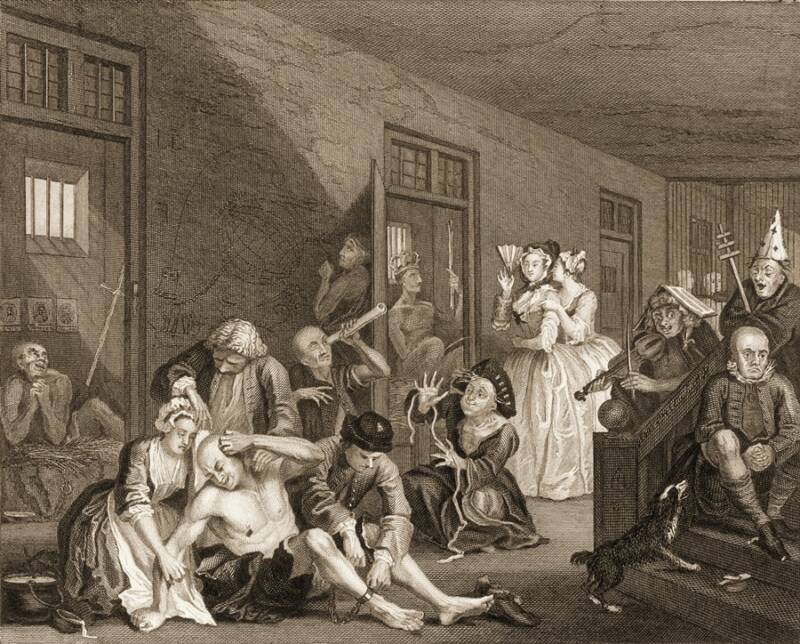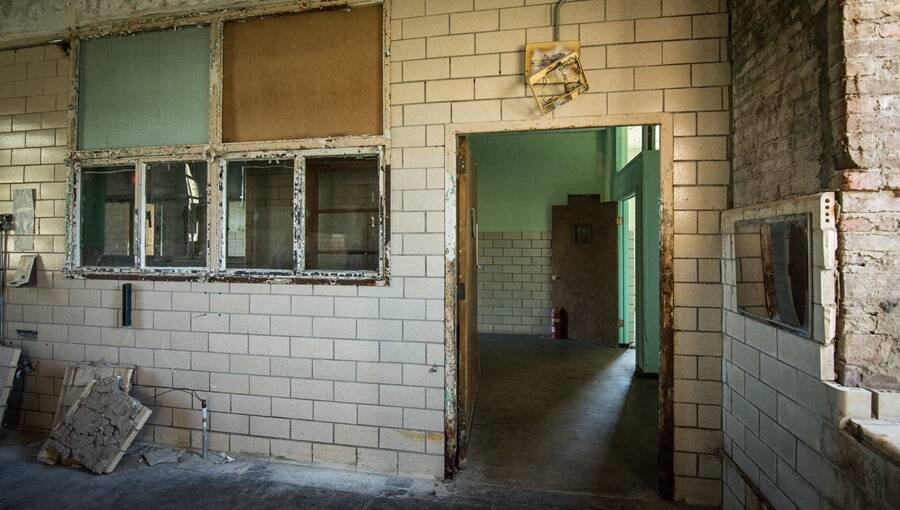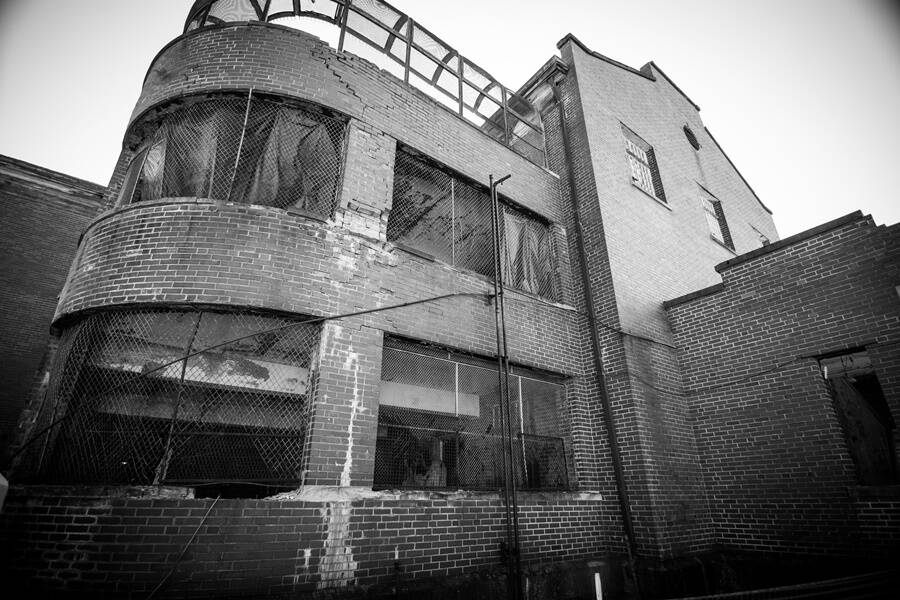From the Trans-Allegheny Lunatic Asylum to the English institution that inspired the word "bedlam," explore the dark history of insane asylums.
Insane asylums have a long, unsavory history — but they weren’t originally intended as sites of horror.
The origins of mental asylums — an antiquated and loaded term that is now retired from the field of mental health treatment — came from a wave of reforms that experts tried to enact in the 19th century.

Stock Montage/Getty ImagesAn engraving depicts a scene at Bedlam, the first asylum in England founded in 1247.
These facilities catered to mentally ill people with treatments that were supposed to be more humane than what was previously available. But mental health stigmatization coupled with an increase in diagnoses led to severely overcrowded hospitals and increasingly cruel behavior toward patients.
These “insane asylums” subsequently turned into prisons where society’s “undesirable citizens” — the “incurables,” criminals, and those with disabilities — were put together as a way to isolate them from the public.
Patients endured horrifying “treatments” like ice baths, electric shock therapy, purging, bloodletting, straitjackets, forced drugging, and even lobotomies — all of which were considered legitimate medical practices at the time.
It wasn’t until the terrifying conditions at these mental health facilities were revealed through undercover investigations and patient witnesses that they were brought to light.
In 1851, Isaac Hunt — a former patient at the Maine Insane Hospital — sued the facility, describing it as the “most iniquitous, villainous system of inhumanity, that would more than match the bloodiest, darkest days of the Inquisition or the tragedies of the Bastille.”
But not all former patients were lucky enough to get out, as Hunt did. Take a look at the most infamous insane asylums from centuries past and the horrors that once took place inside their walls.
Trans-Allegheny Lunatic Asylum: The Mental Health Haven-Turned-Lobotomy Lab

Barbara Nitke/Syfy/NBCU Photo Bank/NBCUniversal via Getty ImagesThe Trans-Allegheny Lunatic Asylum was meant to be a sanctuary for those with mental health conditions.
From the outside, the facade of the Trans-Allegheny Lunatic Asylum looks almost magnificent, with tall brick walls and an elegant belltower on top. But the remnants of its abusive past still linger inside.
The Trans-Allegheny Lunatic Asylum first opened in 1863 in West Virginia. It was the brainchild of Thomas Kirkbride, an American mental health reformist working to improve patient treatments. Kirkbride had advocated for more holistic treatment of mental health patients, which included access to fresh air and sunlight within a healthy and sustainable environment.
Thus, a number of hospitals based on Kirkbride’s progressive treatment philosophy were opened across the country, including the Trans-Allegheny Lunatic Asylum.

Viv Lynch/FlickrAt its peak, the hospital housed over 2,600 patients — ten times its intended population size.
The 250-bed facility was a sanctuary when it first began operating. It featured long spacious hallways, clean private rooms, and high windows and ceilings. The grounds had a sustainable dairy, a working farm, waterworks, a gas well, and a cemetery. But its idyllic days didn’t last very long.
About 20 years after it opened, the facility began to become overwhelmed by patients. An increase in both mental health diagnoses and stigma surrounding those conditions led to a major uptick. By 1938, the Trans-Allegheny Lunatic Asylum was six times over capacity.
Given the severe overcrowding, patients were no longer given private rooms of their own and shared a single bedroom with five to six other patients. There were not enough beds and there was no heating system. Patients deemed unruly were locked in cages in the open halls, a cruel means to regain order by the staff while freeing up space in the bedrooms for less troublesome patients.

Eva Hambach/AFP/Getty ImagesPatients at the hospital were locked up, neglected, and lobotomized.
The staff was vastly outnumbered and overworked, which led to chaos in the halls as patients roamed free with little supervision. The facilities were overrun with squalor, the wallpaper was torn, and the furniture was grimy and dusty. Much like the facilities, the patients were no longer cared for frequently and sometimes even went without treatment or food.
At its peak in the 1950s, the hospital housed 2,600 patients — ten times the number it was intended to serve.
In addition to the facility’s declined sanitation and patient care, a new horror reared its head: an experimental lobotomy laboratory run by Walter Freeman, the infamous surgeon who was a top proponent of the controversial practice.
His “ice pick” method involved slipping a thin pointed rod into the patient’s eye socket and using a hammer to force it to sever the connective tissue in the brain’s prefrontal cortex.

Viv Lynch/FlickrThe abandoned hospital now hosts ghost tours, which have drawn ghost hunters and fans of the supernatural.
It’s unclear exactly how many victims suffered at Freeman’s hands, but it’s estimated that he carried out a total of 4,000 lobotomies in his lifetime. His lobotomies left many patients with lasting physical and cognitive damage — and some even died on the operating table.
The abuse and neglect of patients inside the Trans-Allegheny Lunatic Asylum remained largely unknown to the public until 1949, when The Charleston Gazette reported on the terrifying conditions. Shockingly, it continued its operations until 1994 when the Trans-Allegheny Lunatic Asylum was finally shut down forever.
Today, the manor-like facility is a museum of sorts. Exhibits in the Kirkbride — the main building of the asylum — include art made by patients in the art therapy program, treatments of the past including straitjackets, and even a room dedicated to restraints. Visitors can also take a so-called “paranormal tour” where devout ghost hunters swear they can hear echos of terrors gone by.





